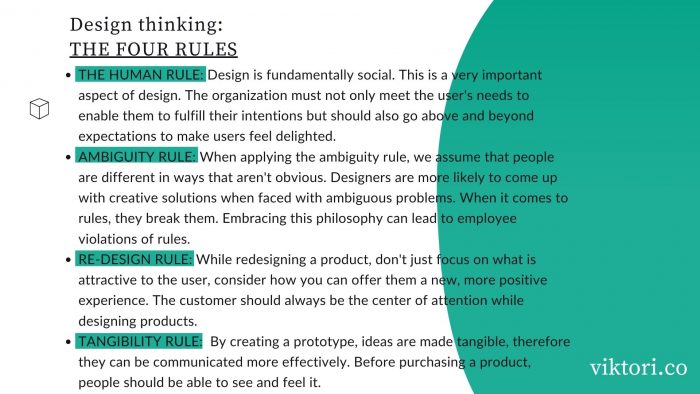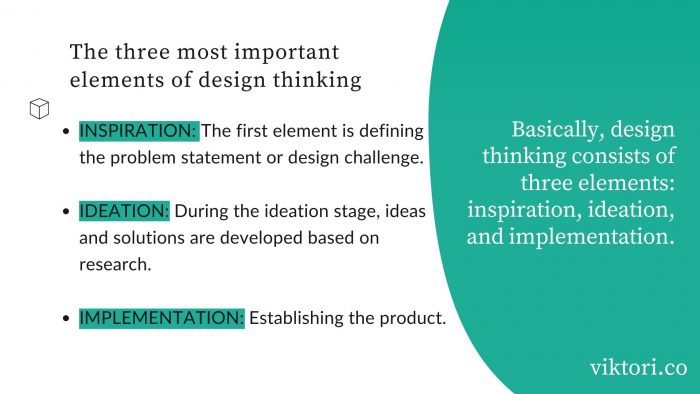Design thinking is a human-centered approach to innovation that integrates people’s needs, technology’s possibilities, and the requirements for business success. As a result, you will be able to give your workforce the tools they need to instill collective genius among them and help people work together to meet shared challenges and goals.
Design thinking is the process of developing design concepts that combine strategy, critical thinking, and creativity.
We aim to identify alternative strategies and solutions that might not be instantly apparent with our initial understanding of the problem by conducting an iterative process in which we seek to understand the user, challenge assumptions, and redefine problems to identify alternative strategies and solutions.
- What is the goal of design thinking?
- Benefits of design thinking
- Design thinking: THE FOUR RULES
- What are the five stages of design thinking?
- The three most important elements of design thinking
- The application of design thinking in business
- Design thinking vs human-centered design
- Design thinking vs systems thinking
- Design thinking vs critical thinking
- Design thinking vs design sprint
- CONCLUSION
What is the goal of design thinking?
Creative problem-solving is the goal of design thinking. It encourages organizations to think about their customers and the people they’re making something for, which results in better products, services, and internal processes.
Benefits of design thinking
- When you apply design thinking to your everyday work, you can uncover new insights almost instantly, constantly reframe problems, and collaborate more effectively within a team.
- Getting to the root of customer needs through design thinking provides innovative design opportunities and lays the groundwork for building products that meet their needs.
- It is a well-known fact that design thinkers are exposed to a broader and more diverse array of potential solutions and new ideas as compared to the traditional, linear approach that emphasizes a single answer.
- Focusing on the end-user is one of the biggest benefits of design thinking. Whether we’re implementing new technology or a new project management process, knowing who will use the solution is the key to understanding exactly how to implement it.

Design thinking: THE FOUR RULES
- THE HUMAN RULE: Design is fundamentally social. This is a very important aspect of design. The organization must not only meet the user’s needs to enable them to fulfill their intentions but should also go above and beyond expectations to make users feel delighted.
- AMBIGUITY RULE: When applying the ambiguity rule, we assume that people are different in ways that aren’t obvious. Designers are more likely to come up with creative solutions when faced with ambiguous problems. When it comes to rules, they break them. Embracing this philosophy can lead to employee violations of rules.
- RE-DESIGN RULE: While redesigning a product, don’t just focus on what is attractive to the user, consider how you can offer them a new, more positive experience. The customer should always be the center of attention while designing products.
- TANGIBILITY RULE: By creating a prototype, ideas are made tangible, therefore they can be communicated more effectively. Before purchasing a product, people should be able to see and feel it.
What are the five stages of design thinking?
Design thinking is a way to solve complex problems. It is a framework for creative thinking. The framework is made up of five stages that help you work through different parts of the creative process.
- Empathize: You should spend a lot of time immersed in the people you’re designing for at this stage. In order to design for the people you need to empathize with, it’s important to spend as much time as possible with them. It involves consulting experts to learn more about an area of concern, observing, engaging, and empathizing with people in order to gain a deeper personal understanding of the issues involved, as well as immersing yourself in the environment to gain a deeper understanding of the situation.
- Define (the problem): What is it that you can do something about? A particular aspect of the larger challenge will be defined and defined boundaries will be identified. Designers will use this stage to analyze the observations completed during the empathy stage and synthesize these observations. After combining the gained information and insight, teams must frame the problem human-centered and create a defining ‘problem statement’.
- Ideate: The third stage is when designers are ready to begin generating ideas. During this stage, teams form logical ideas based on the information collected during the previous stages. This step of the process will center around brainstorming as many ideas as possible and thinking “outside the box” to identify potential solutions to the problem statement which has already been defined in the prior stage. The designers at this stage should be able to have a clear understanding of their user base, so this is a great time to try out some new ideas and not worry so much about the limitations.
- Prototype: Create a physical prototype of your solution; this is where things start to happen. An ideal prototype is needed at this stage, but the ramifications are still flexible. A prototype can range from paper sketches to something as simple as a working model or a beta website.
- Test: The purpose of testing your prototype is to gather user feedback and iterate accordingly. A five-stage model indicates this is the final step, however during an iterative process, the results gathered during testing can be used to redefine problems or to provide information on how to understand users, how they think, behave, and feel as well as to empathize. Often, testing is an iterative process. Designers can anticipate that they will go through a number of edits, changes, and refinements during testing.

The three most important elements of design thinking
- INSPIRATION: The first element is defining the problem statement or design challenge.
- IDEATION: During the ideation stage, ideas and solutions are developed based on research.
- IMPLEMENTATION: Establishing the product.
The application of design thinking in business
Managing a business is quite challenging. A leader can successfully drive their organization with design thinking and connect the dots with it. There are many ways in which design thinking can help you with your business such as: identifying the right problem, deeper understanding of customers, you get more opportunities, launching products and services, etc.
The moment a business decides to launch a new product, a massive, expensive machine kicks into high gear, especially at large corporations. This is a costly process. When you apply design thinking to a project, you can save vast amounts of money right away, as it is aimed at addressing the specific needs of the client – cost savings can be realized almost immediately as a result.
A design thinking approach can be extremely useful when it comes to differentiating your organization, strengthening your business model, implementing a strong culture, engaging your employees or members, or developing a compelling brand.
The focus is on determining the right questions and problems that are important to the users. This is done by interacting with them and understanding their environment.
Design thinking vs human-centered design
Though they differ in subtle ways, design thinking and human-centered design are essentially the same things. Human-centered design is concerned with meeting the needs of the users, whereas design thinking focuses on understanding the needs of the users, and it is a non-linear process.
The core of Human-Centered Design is empathy. The goal of HCD is to develop solutions to problems by bringing a human perspective into every part of the process.
While design thinking thinks about the big picture, human-centered design takes a detailed look at the details and improves the usability of practical services through a human-centered approach.
Design thinking vs systems thinking
The two do not have much in common. The method of design thinking relies on synthesis, and the method of systems thinking relies on analysis.
A design thinking method is a way of approaching open-ended problems by focusing on the human aspect. Rather than concentrating on the details that make the solution possible, systems thinking focuses on high-level strategic issues.
The solutions that are developed by Design Thinking typically involve either redeveloping an existing product or service into something better or creating a completely new product. The purpose of systems thinking, however, is to gain an understanding of how each individual component of a system refers to the other in order to come up with a solution to the problem.
Systems thinking refers to a methodological or disciplined approach, while design thinking emphasizes empathy for users and their contexts over functionality or feasibility to come up with new and unusual solutions.
Design thinking vs critical thinking
It is useful to understand the differences in perspective between critical thinking and design thinking. With design thinking, the user always comes first. To create a successful product, you must understand who your users are and how they interact with your product. The key to solving a problem for a critical thinker is to find its flaws.
Design thinking involves following a set of steps to solve complex problems; this can be achieved by using techniques such as prototyping, user testing, etc. Criticism opposes design thinking as it places a greater emphasis on logic, reason, and rationality. As opposed to looking for creativity or innovation in problem-solving, critical thinking examines claims or arguments.
To evaluate information, critical thinking emphasizes deduction and analysis. Similar methods are used by design thinking, but it takes a creative approach to solve issues.
Co-creation and collaboration are key components of design thinking, and we often apply imagination when thinking about a problem. When we think critically, we are able to use the data and reasoning behind our conclusion to come to a conclusion.
Design thinking vs design sprint
Design Sprints provide a framework for solving problems by designing and testing the right solutions, while Design Thinking provides the methodology and foundation needed to comprehend the needs of a project and the end-user.
Iterative problem-solving with a user-centered approach, multidisciplinary collaboration, and design thinking are the hallmarks of design thinking. The design sprint is a team-based pattern of working which focuses on skills, methods, and tools that are most useful for the kick-off of a project, especially during the early stages of the time when the team is learning about assumptions and risks.
Historically, designers have always used the design thinking process as a means of “conceiving” and “designing” products and services. Design sprints are an innovative way to get quick feedback from stakeholders and users in an organization.
CONCLUSION
We can say with certainty that great design can make the difference between a product that sells and one that does not. By using Design Thinking, we can design products and services which will be valuable to our customers.
A design concept can be thought of as a collection of cognitive, strategic, and practical ideas developed by a number of different processes. Its focus is to focus on human needs and to develop creative, innovative problem-solving processes rather than just pure technical functionality.
Using logic, imagination, intuition, and systemic reasoning, Design Thinking explores possibilities of what could be – and creates beneficial end-products for the end-user.
In education, design thinking is a method that can be used to create solutions to problems present in any discipline.
Thanks for reading and if you’re looking for more, here are some of my other resources on thinking, pitching, processes and strategies:
- 44 Strategist Traits
- Content production system from small to medium-size businesses
- Alternative B2B Lead Generation Approach
- Simple competitor analysis framework
- How to get pricing from competitors
- The 10 best videos on strategy
- Simple Business Development Method
- What Is Creative Strategy
- What is a Creative Strategist
- 44 Efficiency Tips
- Simple Business Development Method

